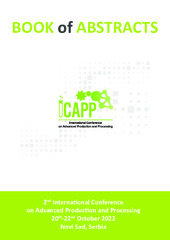Приказ основних података о документу
APPLICATION OF RAMAN SPECTROSCOPY FOR THE CHARACTERISATION OF MILK AND MILK-PHENOLICS POWDERS
| dc.creator | Milinčić, Danijel | |
| dc.creator | Kolašinac, Stefan | |
| dc.creator | Kostić, Aleksandar | |
| dc.creator | Lević, Steva | |
| dc.creator | Salević, Ana | |
| dc.creator | Nedović, Viktor | |
| dc.creator | Pešić, Mirjana | |
| dc.date.accessioned | 2024-02-13T07:59:11Z | |
| dc.date.available | 2024-02-13T07:59:11Z | |
| dc.date.issued | 2022 | |
| dc.identifier.isbn | 978-86-6253-160-5 | |
| dc.identifier.uri | http://aspace.agrif.bg.ac.rs/handle/123456789/6870 | |
| dc.description.abstract | The current trend of food innovations is a development of different milk products enriched with phenolic compounds extracted from food by-products. This represents a promising strategy for food waste recovery and to enhance the beneficial health effects of milk-based functional foods. As one of the promising food ingredients can be skim goat milk enriched with grape pomace seed extract due to improved antioxidant properties of goat milk proteins. So, the aim of this study was the Raman analysis of spray-dried powders of skim goat milk, heated goat milk, and heated goat milk enriched with different concentrations of grape pomace seed extract. The whole statistical procedure (pre-processing and PCA) of Raman spectra was performed independently at Amide I (1700-1600 cm-1), Amide II (1600-1500cm-1), and Amide III (1500-1200cm-1) regions. Raman spectra analysis of amide I and II regions showed a separation between heated and unheated milk due to the loadings for 1650-1653 (α-helix), 1661-1663, 1675, and 1686 cm-1 (turn). Furthermore, in the amide I region, the differences between milk enriched with different concentrations of grape pomace seed extract can be observed due to loadings for wavenumbers in the 1612-1644 cm-1 region. These differences can be related to the changes in the parallel and antiparallel β-sheet structures, differences in the vibrations of the amino acid residues of tyrosine, tryptophan, and phenylalanine and the vibrations of ν(C=C) bonds from the aromatic ring of free flavan-3-ols (catechin, epicatechin, epigallocatechin). For the amide III region, the applied heat treatment and interactions of proteins with phenolic compounds distinguished samples in loadings for wavenumber in 1236-1257 and 1267-1304 cm-1 ranges. These differences can be related to the changes in the α-helix and random coil structures. It can be concluded that PCA separation of analyzed powders in amide I and III regions of Raman spectra caused by the applied thermal treatment, presence of free phenolic compounds, and protein-phenolics interactions, can be used for the characterization of milk and milk-phenolics powders. | sr |
| dc.language.iso | en | sr |
| dc.publisher | University of Novi Sad, Faculty of Technology Novi Sad | sr |
| dc.relation | info:eu-repo/grantAgreement/ScienceFundRS/Ideje/7744714/RS// | sr |
| dc.rights | openAccess | sr |
| dc.rights.uri | https://creativecommons.org/licenses/by/4.0/ | |
| dc.source | Book of Abstracts of the 2nd International Conference on Advanced Production and Processing (ICAPP) | sr |
| dc.subject | Goat milk proteins | sr |
| dc.subject | Grape pomace seed | sr |
| dc.subject | Phenolic compounds | sr |
| dc.subject | Raman spectroscopy | sr |
| dc.subject | Interactions | sr |
| dc.title | APPLICATION OF RAMAN SPECTROSCOPY FOR THE CHARACTERISATION OF MILK AND MILK-PHENOLICS POWDERS | sr |
| dc.type | conferenceObject | sr |
| dc.rights.license | BY | sr |
| dc.citation.spage | 98 | |
| dc.identifier.fulltext | http://aspace.agrif.bg.ac.rs/bitstream/id/26178/Application_of_Raman_pub_2022.pdf | |
| dc.identifier.rcub | https://hdl.handle.net/21.15107/rcub_agrospace_6870 | |
| dc.type.version | publishedVersion | sr |


